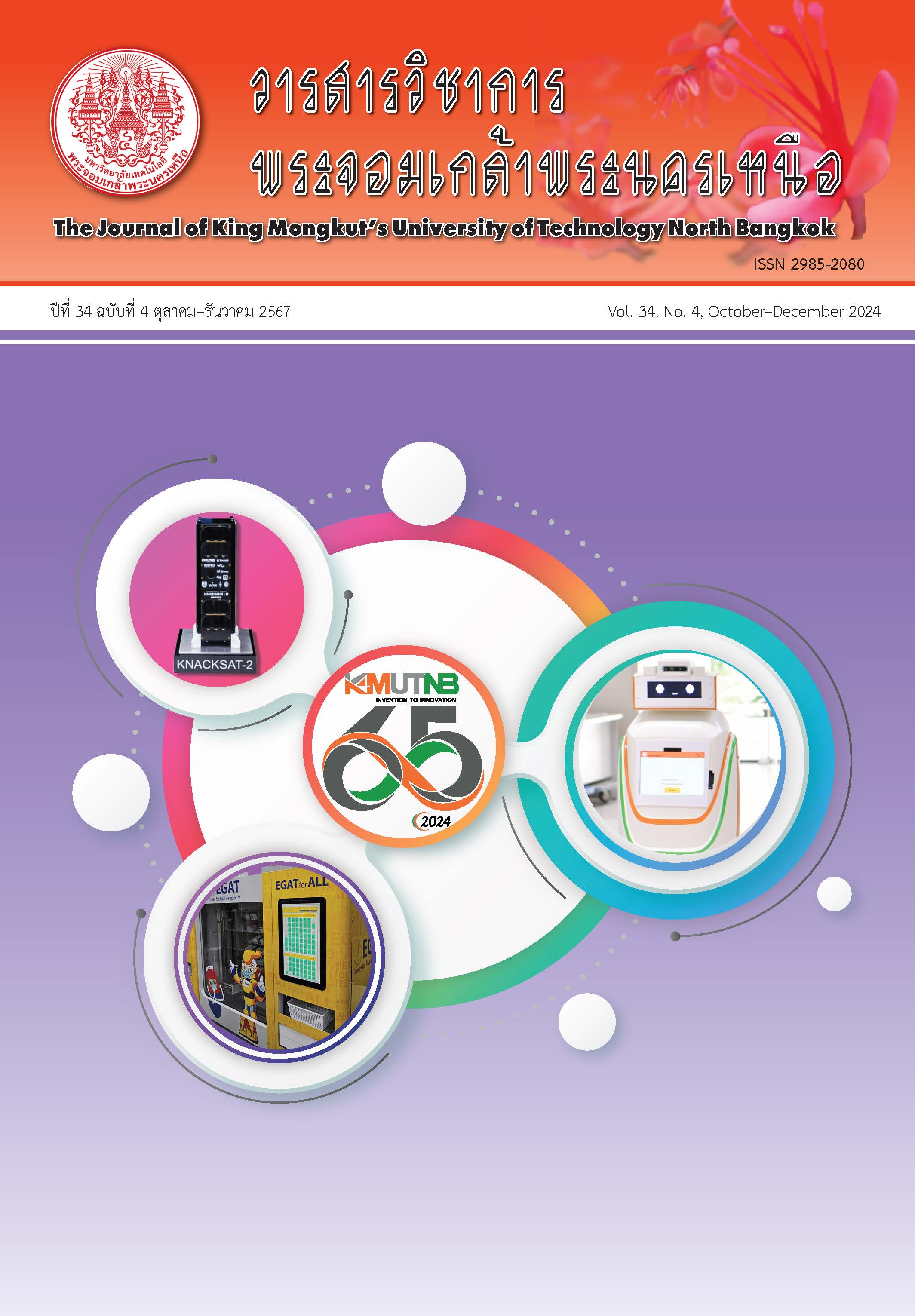การเปรียบเทียบตัวแบบการพยากรณ์ยอดขายของธุรกิจค้าวัสดุก่อสร้าง กรณีศึกษา บริษัท ห้าแยก กรุ๊ป (2559) จำกัด
Main Article Content
บทคัดย่อ
บริษัทกรณีศึกษามีการจัดการสินค้าคงคลังแบบเมื่อสินค้าหมดจะสั่งหรือบางครั้งสั่งซื้อสินค้าแล้วไม่ได้ตรงตามที่สั่งไว้ แล้วไม่มีการบันทึกว่าสั่งอะไรไปบ้าง หลายครั้งจึงจำเป็นต้องรับสินค้าที่ได้สั่งไว้หรือไม่ได้สั่งไว้มาถือครอง จนทำให้สินค้าที่รับมานั้นกลายเป็นสินค้าคงคลังที่ขายไม่ได้ ดังนั้นงานวิจัยนี้มีวัตถุประสงค์เพื่อเปรียบเทียบการพยากรณ์ยอดขายของผลิตภัณฑ์กลุ่มที่มีปริมาณยอดขายจำนวนมาก คือ ปูนปอร์ตแลนด์ และการพยากรณ์ยอดขายของผลิตภัณฑ์กลุ่มที่มีปริมาณยอดขายน้อย คือ ชักโครก โดยทำการเก็บข้อมูลผลิตภัณฑ์ทั้ง 2 ผลิตภัณฑ์ ตั้งแต่เดือนกรกฎาคม 2563 ถึงเดือนกรกฎาคม 2565 รวมเป็นระยะเวลา 25 เดือน โดยใช้การพยากรณ์ทั้งหมด 4 วิธี ประกอบด้วย 1) วิธีการพยากรณ์แบบการเฉลี่ยเคลื่อนที่ 2) วิธีการปรับเรียบแบบเอกซ์โปเนนเชียลดับเบิลของบราวน์ 3) วิธีการปรับเรียบแบบเอกซ์โปเนนเชียลเส้นตรงของโฮลท์ และ 4) วิธีการปรับเรียบแบบเอกซ์โปเนนเชียลของวินเทอร์ เมื่อพิจารณาการใช้เกณฑ์การวัดค่าความแม่นยำด้วยค่าเฉลี่ยของค่าสัมบูรณ์ของเปอร์เซ็นต์ของความคลาดเคลื่อน และพิจารณาการใช้เกณฑ์ค่าเฉลี่ยความผิดพลาดสัมบูรณ์ ที่มีค่าน้อยที่สุด ผลการวิจัยนี้พบว่า ตัวแบบการพยากรณ์ที่เหมาะสมที่สุดของการพยากรณ์ยอดขายล่วงหน้าระยะ 3 เดือน และ 6 เดือน ของผลิตภัณฑ์ปูนปอร์ตแลนด์ คือ วิธีการปรับเรียบแบบเอกซ์โปเนนเชียลดับเบิลของบราวน์ ซึ่งมีค่าเฉลี่ยของค่าสัมบูรณ์ของเปอร์เซ็นต์ของความคลาดเคลื่อนและค่าเฉลี่ยความผิดพลาดสัมบูรณ์ เท่ากับ 7.78% และ 1,818 ตามลำดับ สำหรับตัวแบบการพยากรณ์ที่เหมาะสมที่สุดของการพยากรณ์ยอดขายล่วงหน้าระยะ 6 เดือน ของผลิตภัณฑ์ชักโครก คือ วิธีการปรับเรียบแบบเอกซ์โปเนนเชียลของวินเทอร์ มีค่าเฉลี่ยของค่าสัมบูรณ์ของเปอร์เซ็นต์ของความคลาดเคลื่อนและค่าเฉลี่ยความผิดพลาดสัมบูรณ์ เท่ากับ 42.83% และ 2.833 ตามลำดับ บริษัทสามารถใช้เทคนิคตัวแบบการพยากรณ์เหล่านี้ในการวางแผนสินค้าล่วงหน้าให้สอดคล้องกับยอดขายจริงในช่วงเวลานั้น ๆ ได้
Article Details

อนุญาตภายใต้เงื่อนไข Creative Commons Attribution-NonCommercial-NoDerivatives 4.0 International License.
บทความที่ลงตีพิมพ์เป็นข้อคิดเห็นของผู้เขียนเท่านั้น
ผู้เขียนจะต้องเป็นผู้รับผิดชอบต่อผลทางกฎหมายใดๆ ที่อาจเกิดขึ้นจากบทความนั้น
เอกสารอ้างอิง
F. L. Chen and T. Y. Ou, “Constructing a sales forecasting model by integrating GRA and ELM: A case study for retail industry,” International Journal of Electronic Business Management, vol. 9, no. 2, pp. 107–121, 2011.
S. Aras, D. Kocakoc, and C. Polat “Comparative study on retail sales forecasting between single and combination methods,” Journal of Business Economics and Management, vol. 18, no. 5, pp. 803–832, 2017.
C. Mascle and J. Gosse, “Inventory management maximization based on sales forecast: Case study,” Production Planning & Control, vol. 25, no. 12, pp. 1039–1057, 2013.
N. Kourentzes, J. R. Trapero, and D. K. Barrow, “Optimizing forecasting models for inventory planning,” International Journal of Production Economics, vol. 22, no. 5, 2020.
D. Plinere and A. Borisov “Case study on inventory management improvement,” Information Technology and Management Science, vol. 18, no. 1, pp. 91–96, 2015.
R. D. Snyder, A. B. Koehler, and J. K. Ord, “Forecasting for inventory control with exponential smoothing,” International Journal of Forecasting, vol. 18, no. 1, pp. 5–18, 2002.
F. R. Johnston, J. E. Boyland, M. Meadows, and E. Shale “Some properties of a simple moving average when applied to forecasting a time series,” Journal of the Operational Research Society, vol. 50, no. 12, pp. 1267–1271, 1999.
Division of Logistics. (2021) “Industrial Logistics Performance Index : ILPI,” Department of industrial Promotion, [Online]. Available: https://dol.dip.go.th/uploadcontent/DOL/ FON/iLPI/iLPI.pdf.
S. Kohli, G. T. Godwin, and S. Urolagin, “Sales prediction using linear and KNN regression” in Advances in machine learning and computational intelligence. Singapore: Springer, pp. 321–329, 2021.
D. M. Khairina, R. Khairunnisa, H. R. Hatta, and S. Maharani, “Comparison of the trend moment and double moving average methods for forecasting the number of dengue hemorrhagic fever patients,” Bulletin of Electrical Engineering and Informatics, vol. 10, no. 2, pp. 978–987, 2021.
D. M. Khairina, Y. Daniel, and P. P. Widagdo, “Comparison of double exponential smoothing and triple exponential smoothing methods in predicting income of local water company,” presented at Journal of Physics: Conference Series, Volume 1943, 10th International Seminar on New Paradigm and Innovation of Natural Sciences and its Application (ISNPINSA), Indonesia, 24–25 September, 2020.
F. C. Yang, “Efficiency decomposition in dealers from the perspectives of demand forecasting, sales force, and inventory control: A case study,” Production Planning & Control, vol. 27, no. 16, pp. 1334–1343, August 2016.
A. Kengpol and T. Salakkam, “Development of optimized scrap forecasting model in hard disk drive industry,” The Journal of KMUTNB, vol. 24, no. 2, pp. 318–328, 2014 (in Thai).

